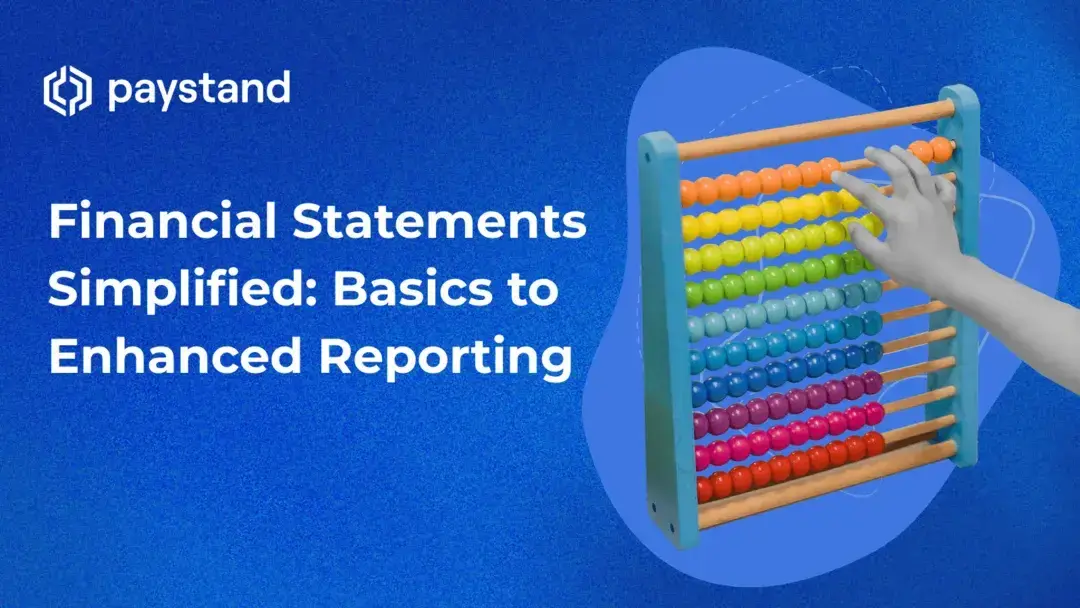Financial Statements Simplified: Basics to Enhanced Reporting

Table of Contents
- What are the Main Types of Financial Statements?
- How Do Financial Statements Work?
- The Benefits of Financial Statements
- How to Read Financial Statements
- The Role of Financial Reporting and Financial Data
- How Paystand Enhances Financial Statements
Key Takeaways
- Financial statements are crucial tools for understanding a company's financial health.
- They provide a snapshot of a company's assets, liabilities, equity, revenues, and expenses.
- Financial reporting and data ensure accuracy and transparency in financial information.
- Paystand's automation can significantly enhance the quality and efficiency of financial reporting.
Financial statements are formal records of a company's financial activities. They provide a structured way to assess a company’s financial health, performance, and cash flow. These statements are essential for stakeholders, including investors, creditors, management, and regulatory bodies, to make informed decisions.
What are the Main Types of Financial Statements?
There are three primary financial statements:
- Balance Sheet: A snapshot of a company's assets, liabilities, and equity at a specific point in time. It follows the basic accounting equation: Assets = Liabilities + Equity.
- Income Statement: Also known as the profit and loss (P&L) statement, it reports a company’s financial performance over a specific period, showing revenues, expenses, and net income (or loss).
- Cash Flow Statement: Tracks the movement of cash both into and out of a company over a period, categorized into operating, investing, and financing activities.

How Do Financial Statements Work?
Financial statements work by summarizing a company's financial transactions into standardized formats. The data is collected through accounting processes and is classified and organized according to Generally Accepted Accounting Principles (GAAP) or International Financial Reporting Standards (IFRS). These principles ensure consistency and comparability, making analyzing and benchmarking a company’s performance easier. Financial statements result from financial reporting, which is the process of creating these statements using financial data. For more on this, see financial data and financial reporting.
The Benefits of Financial Statements
Financial statements offer numerous benefits, including:
- Performance Measurement: They allow companies to assess their operational effectiveness and profitability.
- Investment Decisions: Investors use these statements to gauge a company's potential for returns and risk.
- Creditworthiness Assessment: Lenders use financial statements to evaluate a company’s ability to repay loans.
- Strategic Planning: Management teams utilize financial data to make informed operations, investments, and financing decisions.
- Compliance: They ensure regulatory compliance and transparency.
How to Read Financial Statements
Reading financial statements effectively involves understanding the key components and their interrelationships. Here's a basic guide:
Understanding the Balance Sheet
- Assets: What the company owns—including cash, accounts receivable, inventory, and property, plant, and equipment (PP&E).
- Liabilities: What the company owes to others—including accounts payable, loans, and bonds.
- Equity: The owners’ stake in the company—including common stock, retained earnings, and other reserves.
- Analysis: To evaluate the company's financial stability, look at the debt-to-equity ratio, current ratio (current assets/current liabilities), and quick ratio (acid test).
Analyzing the Income Statement
- Revenue: The income generated from sales of goods or services.
- Cost of Goods Sold (COGS): Direct costs associated with producing goods.
- Gross Profit: Revenue minus COGS.
- Operating Expenses: Costs incurred in running the business, such as salaries, rent, and marketing.
- Operating Income: Gross profit minus operating expenses.
- Net Income: The “bottom line,” calculated by deducting interest and taxes from operating income.
- Analysis: Calculate gross profit margin (gross profit/revenue) and net profit margin (net profit/revenue) to evaluate profitability.
Reviewing the Cash Flow Statement
- Operating Activities: Cash flows from the day-to-day running of the business.
- Investing Activities: Cash flows from purchases and sales of long-term assets.
- Financing Activities: Cash flows from borrowing and repaying debts, raising capital, and paying dividends.
- Analysis: Ensure the company has positive cash flow from operating activities, and assess if cash is being spent appropriately.
The Role of Financial Reporting and Financial Data
Financial reporting is preparing and presenting financial statements, following accounting standards to provide a transparent view of a company's financial position and performance. Financial data is the raw information used in creating these reports. Proper financial reporting ensures data is accurate, reliable, and comparable, providing a solid foundation for informed decision-making.
How Paystand Enhances Financial Statements
Paystand leverages blockchain technology to provide real-time payments and automated financial processes, enhancing financial statements' accuracy, efficiency, and transparency. This is a critical part of finance digital transformation. Here's how:
- Automated Invoicing: Paystand automates the invoicing process, reducing errors and improving the speed of invoice generation and distribution. This directly impacts the data going into income statements, providing more accurate revenue figures.
- Real-Time Payments: By facilitating real-time payments, Paystand accelerates cash flow, which is reflected in the cash flow statement, providing a clearer view of a company's liquidity position. Using tokenized assets on permissionless blockchains enables instant settlement and eliminates the delays associated with traditional payment systems.
- Accounts Receivable Management: Paystand’s platform helps manage accounts receivable more efficiently, reducing outstanding debts and bad debt write-offs and improving the balance sheet by ensuring assets are accurate and current. This is essential for a company's health as it impacts liquidity.
- Transaction Transparency: Paystand records all transactions on an immutable, transparent ledger (blockchain), providing a secure and verifiable audit trail. This transparency enhances the reliability of financial data. Permissionless networks offer this unprecedented level of transparency, which also aids in detecting anomalies and financial crime.
- Cost Savings: By automating manual processes, reducing transaction fees, and eliminating paper-based systems, Paystand helps companies lower operational costs, positively impacting the income statement and improving net income. These improvements are key components of effective business financial management.
Financial statements are critical for understanding a company’s financial health and performance. With business transactions becoming increasingly complex, tools that automate, provide real-time information, and enhance transparency are essential. Paystand’s innovative platform leverages the power of permissionless networks and tokenization to offer significant improvements in financial reporting, aligning well with the future of finance. By embracing these technological advancements, companies can make better decisions, improve efficiency, and achieve greater success. Learn more about how Paystand can help your business in our latest ebook.





%20(1)%20(1).jpg?width=100&height=100&name=IMG_3752%20(1)%20(1)%20(1).jpg)